spare tire TOYOTA AURIS 2017 Owners Manual (in English)
[x] Cancel search | Manufacturer: TOYOTA, Model Year: 2017, Model line: AURIS, Model: TOYOTA AURIS 2017Pages: 661, PDF Size: 26.83 MB
Page 6 of 661
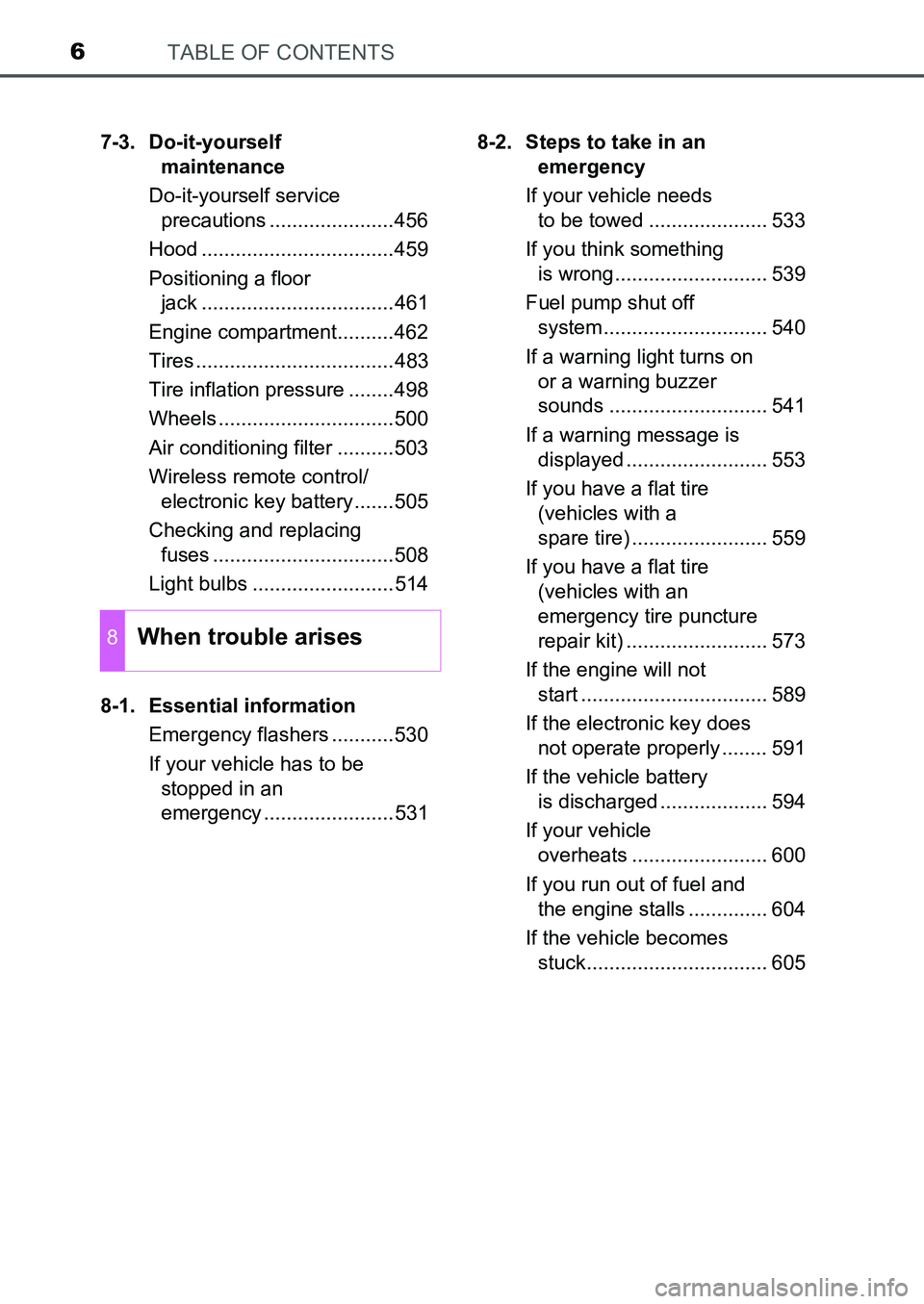
TABLE OF CONTENTS6
UK AURIS_HB_EE (OM12K97E)7-3. Do-it-yourself
maintenance
Do-it-yourself service
precautions ......................456
Hood ..................................459
Positioning a floor
jack ..................................461
Engine compartment..........462
Tires ...................................483
Tire inflation pressure ........498
Wheels ...............................500
Air conditioning filter ..........503
Wireless remote control/
electronic key battery .......505
Checking and replacing
fuses ................................508
Light bulbs .........................514
8-1. Essential information
Emergency flashers ...........530
If your vehicle has to be
stopped in an
emergency .......................5318-2. Steps to take in an
emergency
If your vehicle needs
to be towed ..................... 533
If you think something
is wrong........................... 539
Fuel pump shut off
system............................. 540
If a warning light turns on
or a warning buzzer
sounds ............................ 541
If a warning message is
displayed ......................... 553
If you have a flat tire
(vehicles with a
spare tire) ........................ 559
If you have a flat tire
(vehicles with an
emergency tire puncture
repair kit) ......................... 573
If the engine will not
start ................................. 589
If the electronic key does
not operate properly ........ 591
If the vehicle battery
is discharged ................... 594
If your vehicle
overheats ........................ 600
If you run out of fuel and
the engine stalls .............. 604
If the vehicle becomes
stuck................................ 605
8When trouble arises
UK AURIS_HB_OM_Europe_OM12K97E.book 6 ページ 2016年6月27日 月曜日 午後5時42分
Page 208 of 661
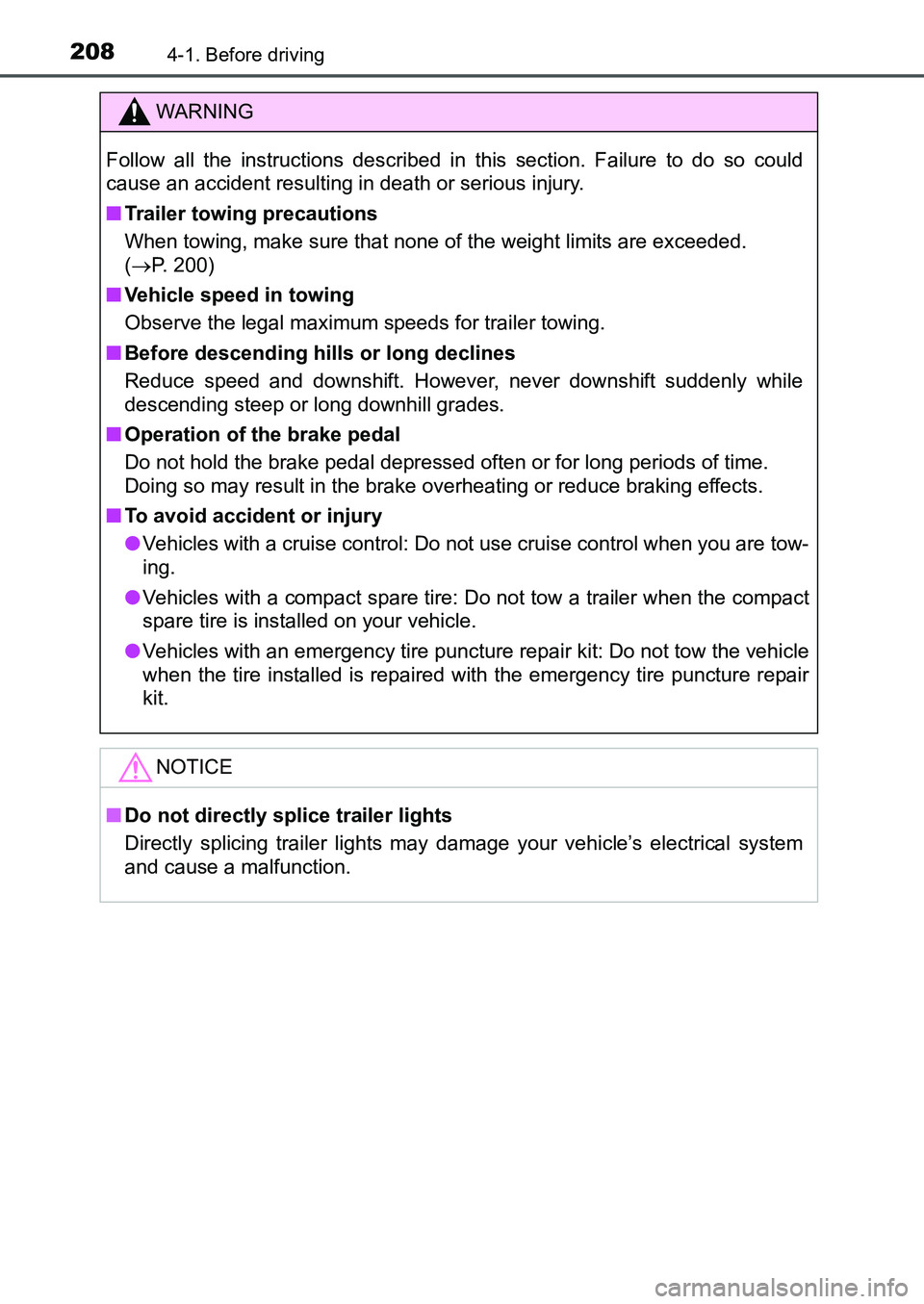
2084-1. Before driving
UK AURIS_HB_EE (OM12K97E)
WARNING
Follow all the instructions described in this section. Failure to do so could
cause an accident resulting in death or serious injury.
■Trailer towing precautions
When towing, make sure that none of the weight limits are exceeded.
(P. 200)
■Vehicle speed in towing
Observe the legal maximum speeds for trailer towing.
■Before descending hills or long declines
Reduce speed and downshift. However, never downshift suddenly while
descending steep or long downhill grades.
■Operation of the brake pedal
Do not hold the brake pedal depressed often or for long periods of time.
Doing so may result in the brake overheating or reduce braking effects.
■To avoid accident or injury
●Vehicles with a cruise control: Do not use cruise control when you are tow-
ing.
●Vehicles with a compact spare tire: Do not tow a trailer when the compact
spare tire is installed on your vehicle.
●Vehicles with an emergency tire puncture repair kit: Do not tow the vehicle
when the tire installed is repaired with the emergency tire puncture repair
kit.
NOTICE
■Do not directly splice trailer lights
Directly splicing trailer lights may damage your vehicle’s electrical system
and cause a malfunction.
UK AURIS_HB_OM_Europe_OM12K97E.book 208 ページ 2016年6月27日 月曜日 午後5時42分
Page 260 of 661
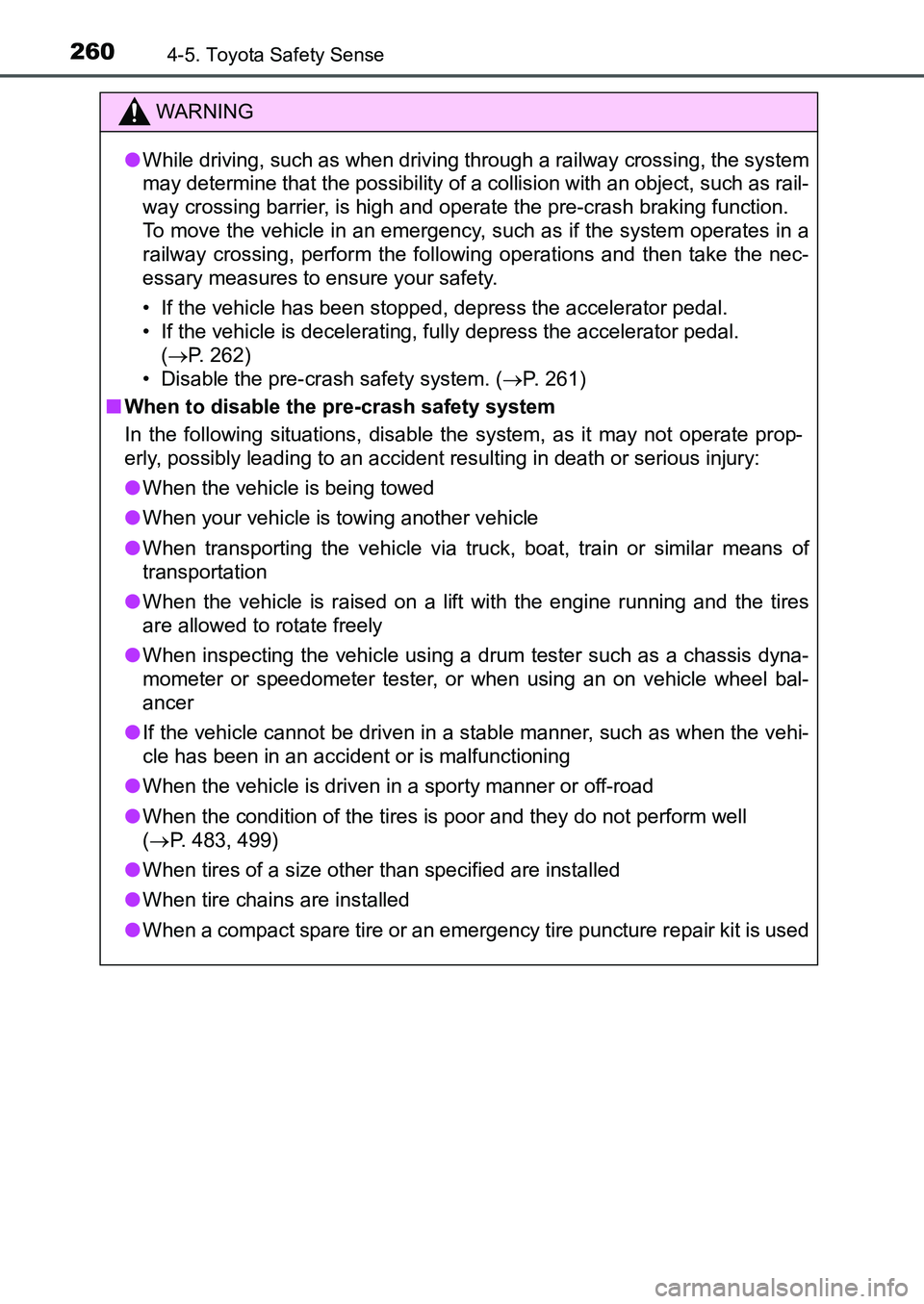
2604-5. Toyota Safety Sense
UK AURIS_HB_EE (OM12K97E)
WARNING
●While driving, such as when driving through a railway crossing, the system
may determine that the possibility of a collision with an object, such as rail-
way crossing barrier, is high and operate the pre-crash braking function.
To move the vehicle in an emergency, such as if the system operates in a
railway crossing, perform the following operations and then take the nec-
essary measures to ensure your safety.
• If the vehicle has been stopped, depress the accelerator pedal.
• If the vehicle is decelerating, fully depress the accelerator pedal.
(P. 262)
• Disable the pre-crash safety system. (P. 261)
■When to disable the pre-crash safety system
In the following situations, disable the system, as it may not operate prop-
erly, possibly leading to an accident resulting in death or serious injury:
●When the vehicle is being towed
●When your vehicle is towing another vehicle
●When transporting the vehicle via truck, boat, train or similar means of
transportation
●When the vehicle is raised on a lift with the engine running and the tires
are allowed to rotate freely
●When inspecting the vehicle using a drum tester such as a chassis dyna-
mometer or speedometer tester, or when using an on vehicle wheel bal-
ancer
●If the vehicle cannot be driven in a stable manner, such as when the vehi-
cle has been in an accident or is malfunctioning
●When the vehicle is driven in a sporty manner or off-road
●When the condition of the tires is poor and they do not perform well
(P. 483, 499)
●When tires of a size other than specified are installed
●When tire chains are installed
●When a compact spare tire or an emergency tire puncture repair kit is used
UK AURIS_HB_OM_Europe_OM12K97E.book 260 ページ 2016年6月27日 月曜日 午後5時42分
Page 327 of 661
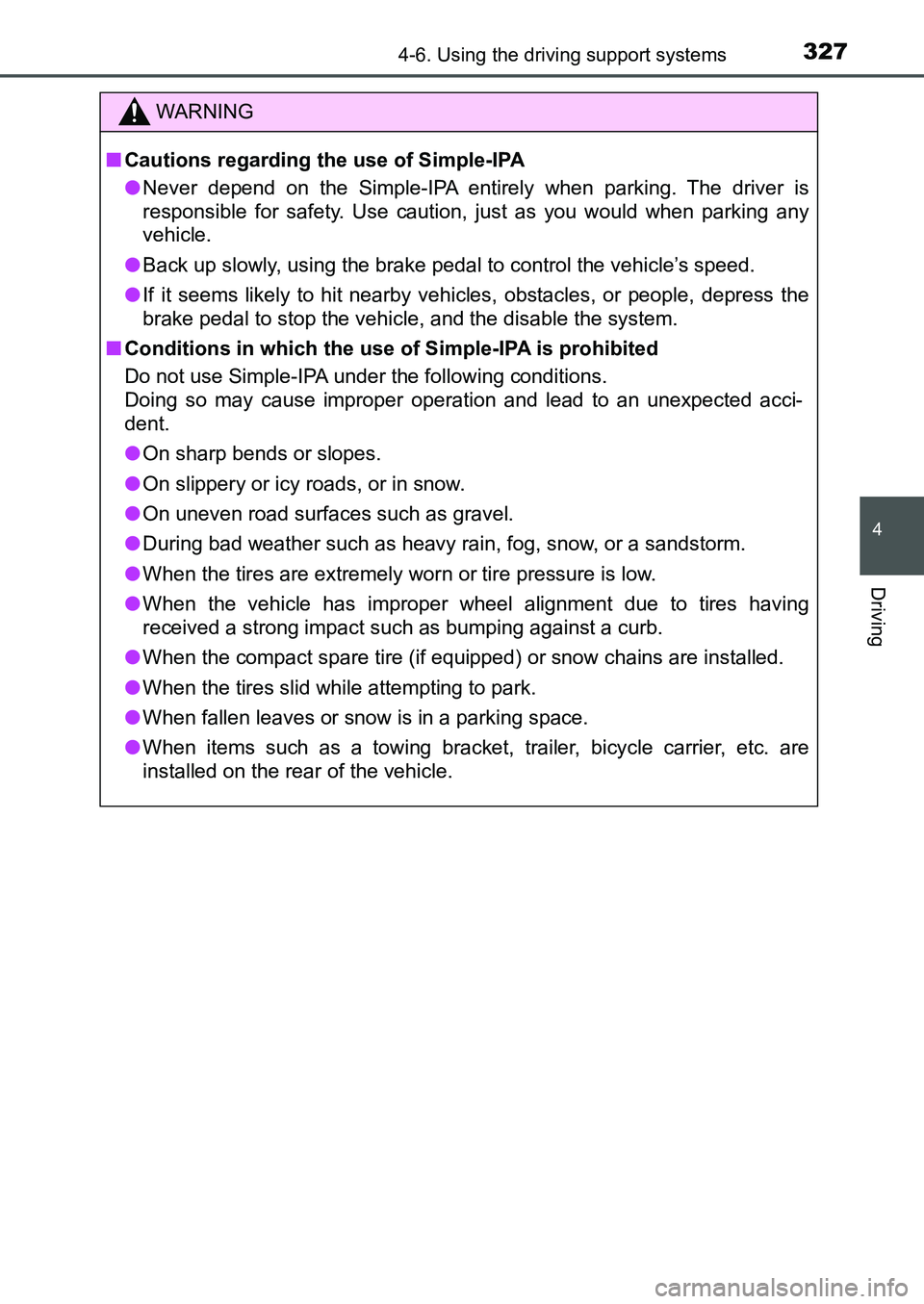
3274-6. Using the driving support systems
UK AURIS_HB_EE (OM12K97E)
4
Driving
WARNING
■Cautions regarding the use of Simple-IPA
●Never depend on the Simple-IPA entirely when parking. The driver is
responsible for safety. Use caution, just as you would when parking any
vehicle.
●Back up slowly, using the brake pedal to control the vehicle’s speed.
●If it seems likely to hit nearby vehicles, obstacles, or people, depress the
brake pedal to stop the vehicle, and the disable the system.
■Conditions in which the use of Simple-IPA is prohibited
Do not use Simple-IPA under the following conditions.
Doing so may cause improper operation and lead to an unexpected acci-
dent.
●On sharp bends or slopes.
●On slippery or icy roads, or in snow.
●On uneven road surfaces such as gravel.
●During bad weather such as heavy rain, fog, snow, or a sandstorm.
●When the tires are extremely worn or tire pressure is low.
●When the vehicle has improper wheel alignment due to tires having
received a strong impact such as bumping against a curb.
●When the compact spare tire (if equipped) or snow chains are installed.
●When the tires slid while attempting to park.
●When fallen leaves or snow is in a parking space.
●When items such as a towing bracket, trailer, bicycle carrier, etc. are
installed on the rear of the vehicle.
UK AURIS_HB_OM_Europe_OM12K97E.book 327 ページ 2016年6月27日 月曜日 午後5時42分
Page 483 of 661
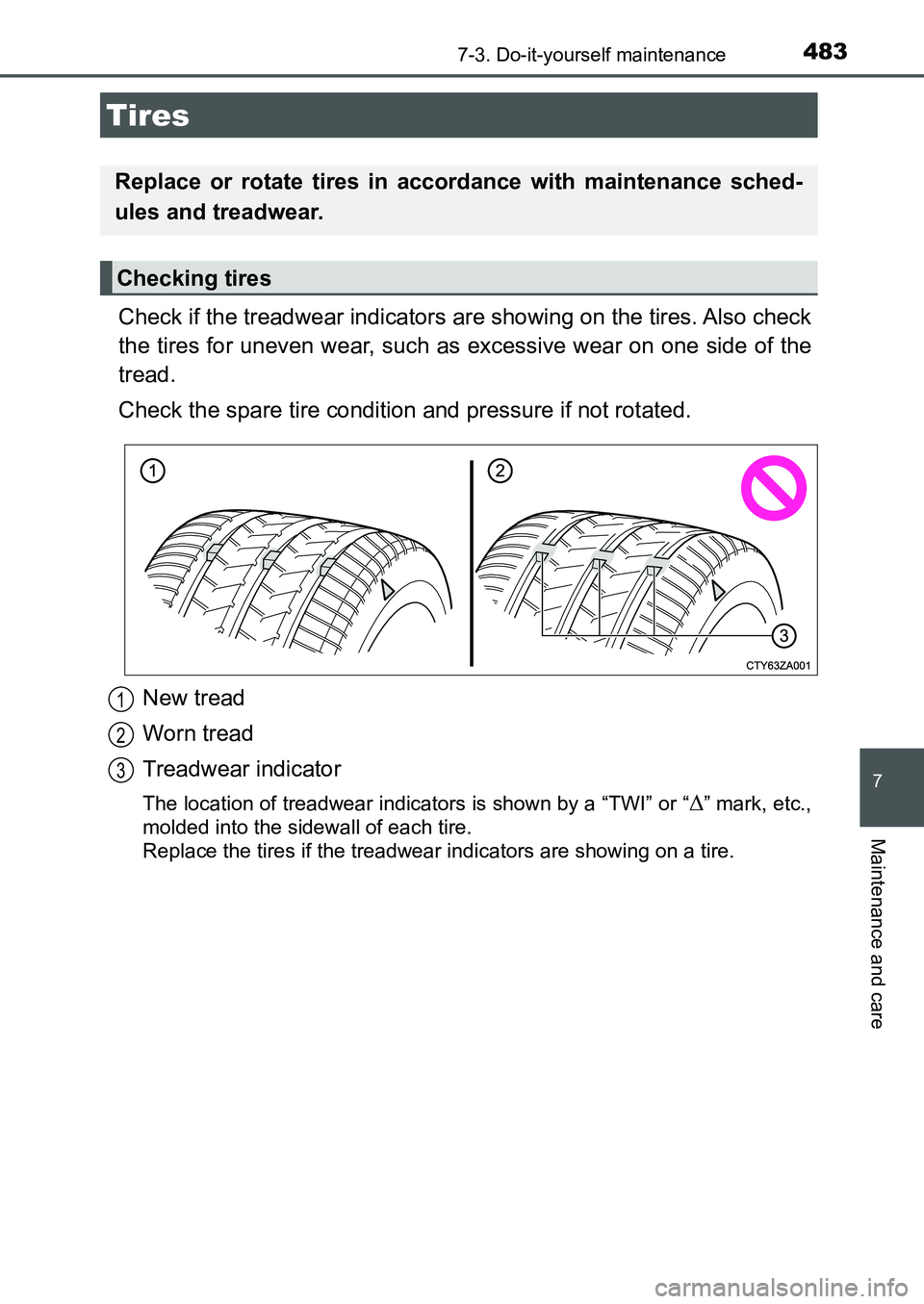
4837-3. Do-it-yourself maintenance
UK AURIS_HB_EE (OM12K97E)
7
Maintenance and care
Check if the treadwear indicators are showing on the tires. Also check
the tires for uneven wear, such as excessive wear on one side of the
tread.
Check the spare tire condition and pressure if not rotated.
New tread
Worn tread
Treadwear indicator
The location of treadwear indicators is shown by a “TWI” or “” mark, etc.,
molded into the sidewall of each tire.
Replace the tires if the treadwear indicators are showing on a tire.
Tires
Replace or rotate tires in accordance with maintenance sched-
ules and treadwear.
Checking tires
1
2
3
UK AURIS_HB_OM_Europe_OM12K97E.book 483 ページ 2016年6月27日 月曜日 午後5時42分
Page 484 of 661
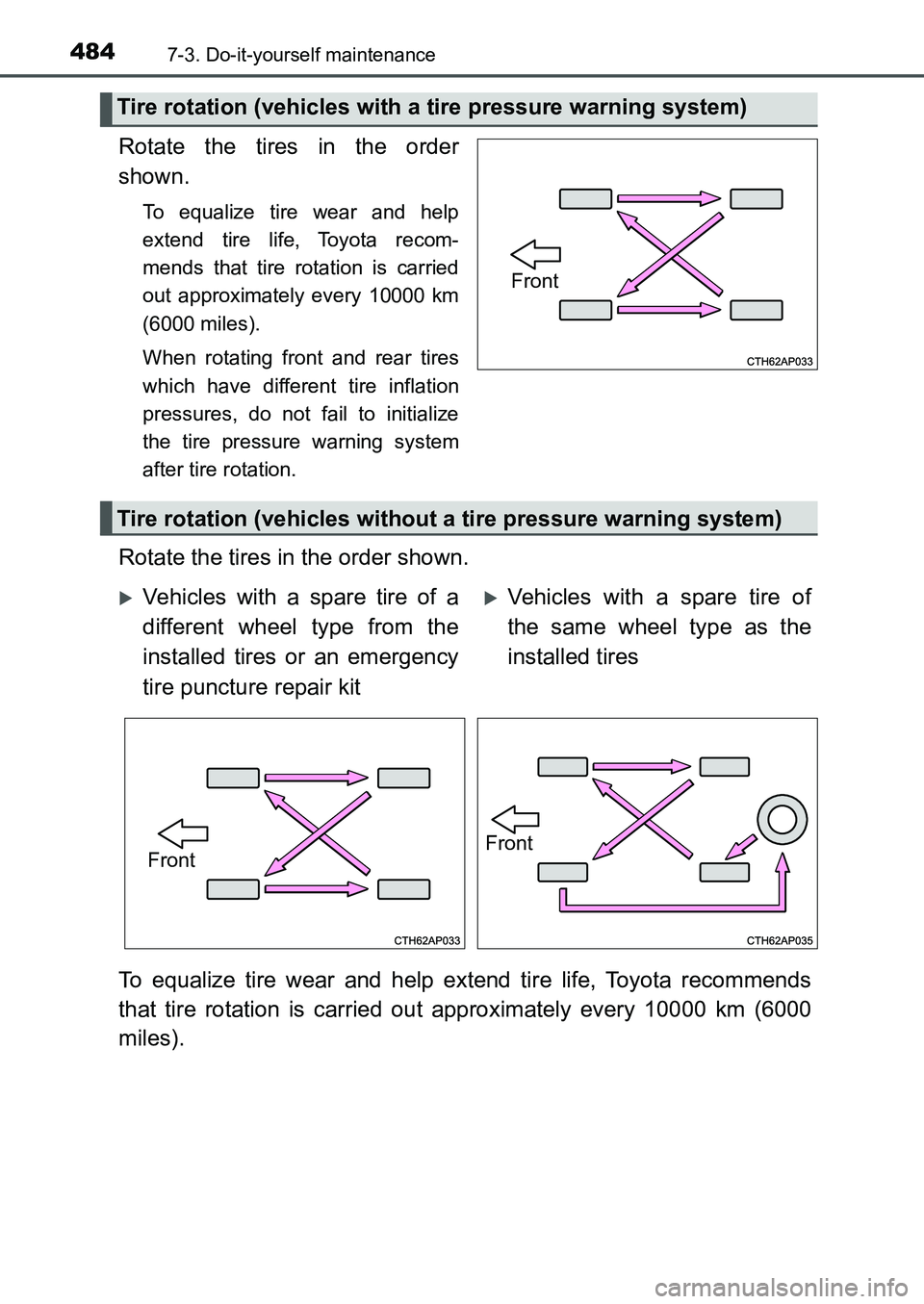
4847-3. Do-it-yourself maintenance
UK AURIS_HB_EE (OM12K97E)
Rotate the tires in the order
shown.
To equalize tire wear and help
extend tire life, Toyota recom-
mends that tire rotation is carried
out approximately every 10000 km
(6000 miles).
When rotating front and rear tires
which have different tire inflation
pressures, do not fail to initialize
the tire pressure warning system
after tire rotation.
Rotate the tires in the order shown.
To equalize tire wear and help extend tire life, Toyota recommends
that tire rotation is carried out approximately every 10000 km (6000
miles).
Tire rotation (vehicles with a tire pressure warning system)
Front
Tire rotation (vehicles without a tire pressure warning system)
Vehicles with a spare tire of a
different wheel type from the
installed tires or an emergency
tire puncture repair kitVehicles with a spare tire of
the same wheel type as the
installed tires
FrontFront
UK AURIS_HB_OM_Europe_OM12K97E.book 484 ページ 2016年6月27日 月曜日 午後5時42分
Page 496 of 661
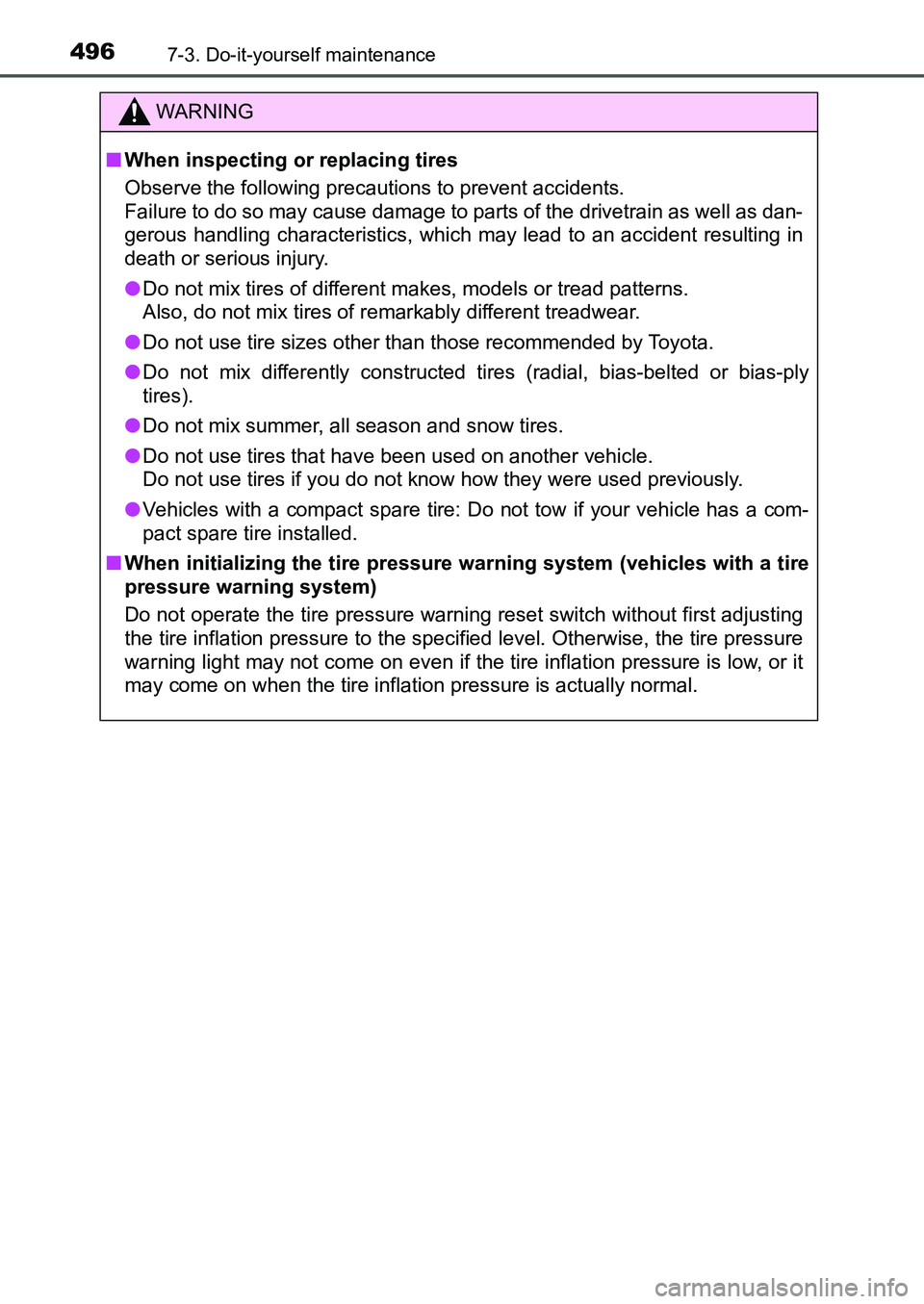
4967-3. Do-it-yourself maintenance
UK AURIS_HB_EE (OM12K97E)
WARNING
■When inspecting or replacing tires
Observe the following precautions to prevent accidents.
Failure to do so may cause damage to parts of the drivetrain as well as dan-
gerous handling characteristics, which may lead to an accident resulting in
death or serious injury.
●Do not mix tires of different makes, models or tread patterns.
Also, do not mix tires of remarkably different treadwear.
●Do not use tire sizes other than those recommended by Toyota.
●Do not mix differently constructed tires (radial, bias-belted or bias-ply
tires).
●Do not mix summer, all season and snow tires.
●Do not use tires that have been used on another vehicle.
Do not use tires if you do not know how they were used previously.
●Vehicles with a compact spare tire: Do not tow if your vehicle has a com-
pact spare tire installed.
■When initializing the tire pressure warning system (vehicles with a tire
pressure warning system)
Do not operate the tire pressure warning reset switch without first adjusting
the tire inflation pressure to the specified level. Otherwise, the tire pressure
warning light may not come on even if the tire inflation pressure is low, or it
may come on when the tire inflation pressure is actually normal.
UK AURIS_HB_OM_Europe_OM12K97E.book 496 ページ 2016年6月27日 月曜日 午後5時42分
Page 500 of 661
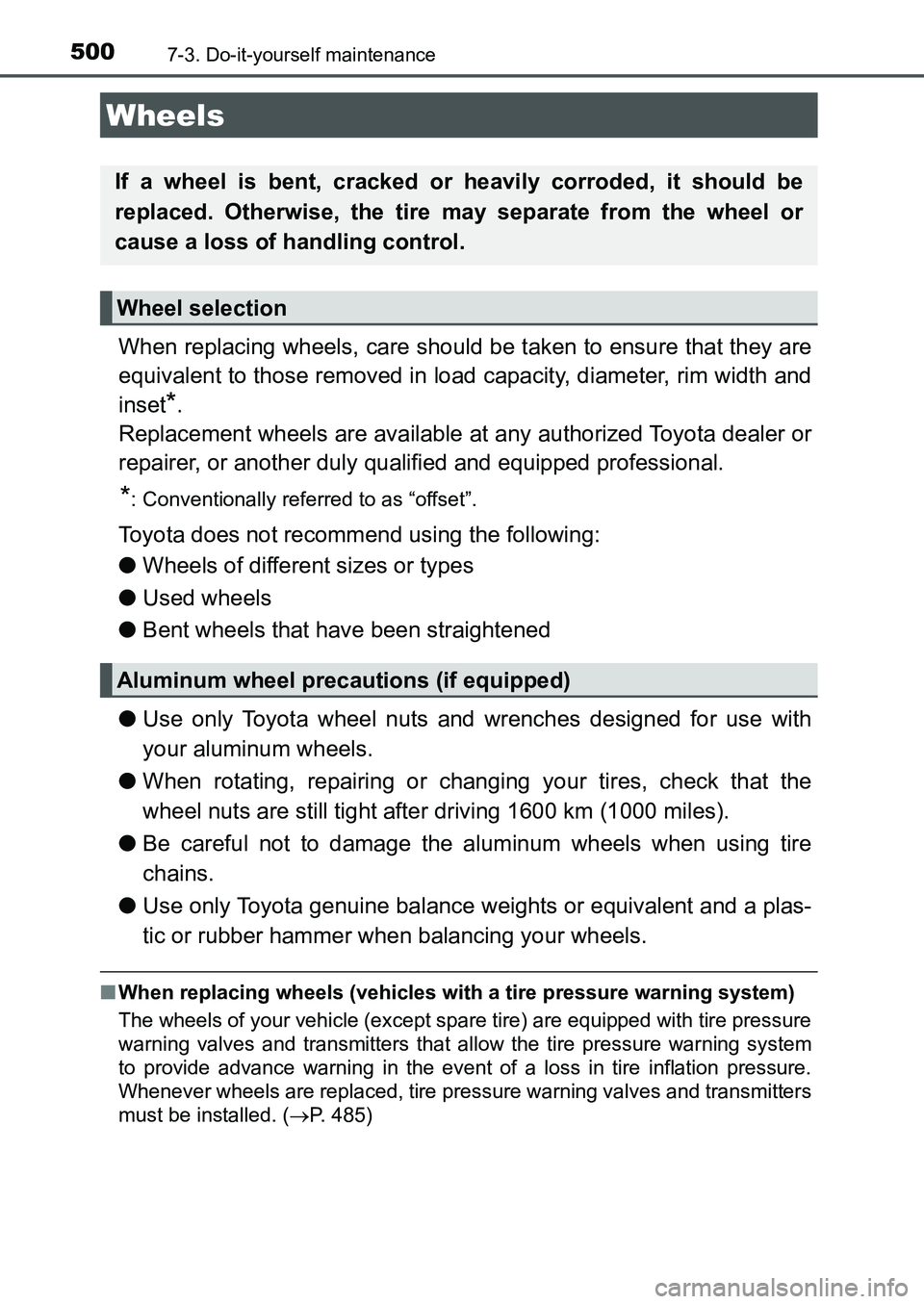
5007-3. Do-it-yourself maintenance
UK AURIS_HB_EE (OM12K97E)
When replacing wheels, care should be taken to ensure that they are
equivalent to those removed in load capacity, diameter, rim width and
inset
*.
Replacement wheels are available at any authorized Toyota dealer or
repairer, or another duly qualified and equipped professional.
*: Conventionally referred to as “offset”.
Toyota does not recommend using the following:
●Wheels of different sizes or types
●Used wheels
●Bent wheels that have been straightened
●Use only Toyota wheel nuts and wrenches designed for use with
your aluminum wheels.
●When rotating, repairing or changing your tires, check that the
wheel nuts are still tight after driving 1600 km (1000 miles).
●Be careful not to damage the aluminum wheels when using tire
chains.
●Use only Toyota genuine balance weights or equivalent and a plas-
tic or rubber hammer when balancing your wheels.
■When replacing wheels (vehicles with a tire pressure warning system)
The wheels of your vehicle (except spare tire) are equipped with tire pressure
warning valves and transmitters that allow the tire pressure warning system
to provide advance warning in the event of a loss in tire inflation pressure.
Whenever wheels are replaced, tire pressure warning valves and transmitters
must be installed. (P. 485)
Wheels
If a wheel is bent, cracked or heavily corroded, it should be
replaced. Otherwise, the tire may separate from the wheel or
cause a loss of handling control.
Wheel selection
Aluminum wheel precautions (if equipped)
UK AURIS_HB_OM_Europe_OM12K97E.book 500 ページ 2016年6月27日 月曜日 午後5時42分
Page 529 of 661
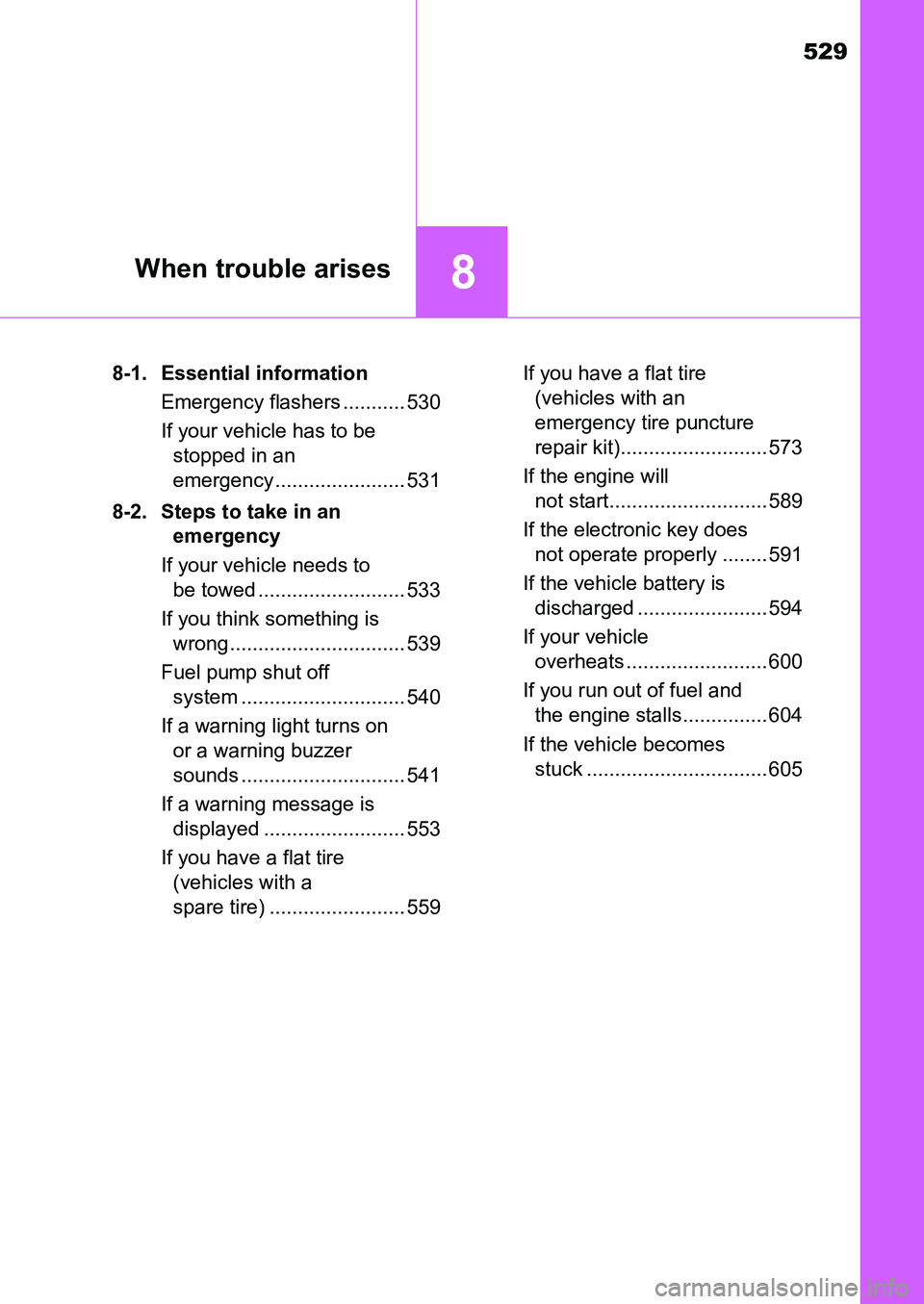
529
8When trouble arises
UK AURIS_HB_EE (OM12K97E)8-1. Essential information
Emergency flashers ........... 530
If your vehicle has to be
stopped in an
emergency....................... 531
8-2. Steps to take in an
emergency
If your vehicle needs to
be towed .......................... 533
If you think something is
wrong ............................... 539
Fuel pump shut off
system ............................. 540
If a warning light turns on
or a warning buzzer
sounds ............................. 541
If a warning message is
displayed ......................... 553
If you have a flat tire
(vehicles with a
spare tire) ........................ 559If you have a flat tire
(vehicles with an
emergency tire puncture
repair kit).......................... 573
If the engine will
not start............................ 589
If the electronic key does
not operate properly ........ 591
If the vehicle battery is
discharged ....................... 594
If your vehicle
overheats ......................... 600
If you run out of fuel and
the engine stalls............... 604
If the vehicle becomes
stuck ................................ 605
UK AURIS_HB_OM_Europe_OM12K97E.book 529 ページ 2016年6月27日 月曜日 午後5時42分
Page 549 of 661
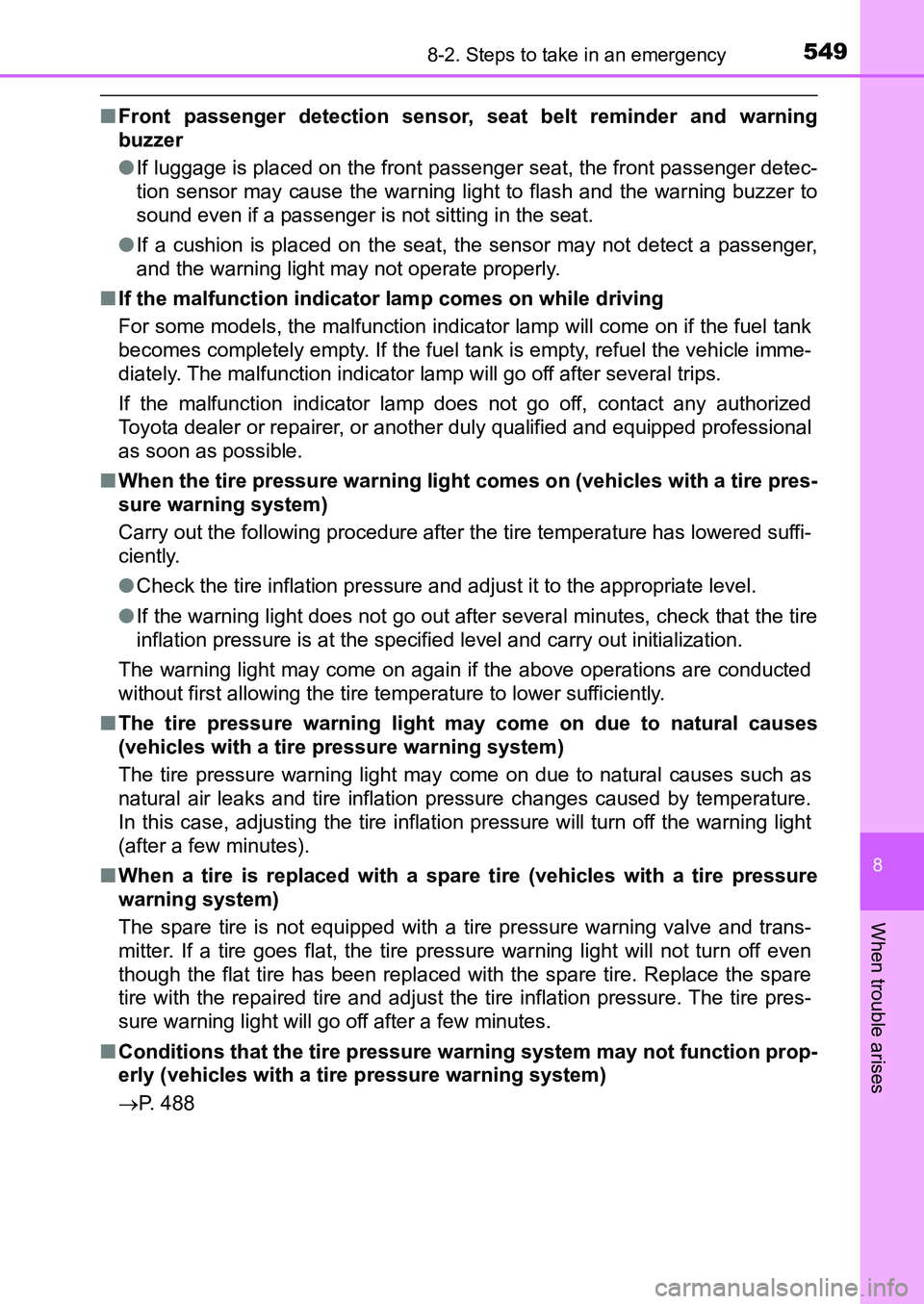
5498-2. Steps to take in an emergency
UK AURIS_HB_EE (OM12K97E)
8
When trouble arises
■Front passenger detection sensor, seat belt reminder and warning
buzzer
●If luggage is placed on the front passenger seat, the front passenger detec-
tion sensor may cause the warning light to flash and the warning buzzer to
sound even if a passenger is not sitting in the seat.
●If a cushion is placed on the seat, the sensor may not detect a passenger,
and the warning light may not operate properly.
■If the malfunction indicator lamp comes on while driving
For some models, the malfunction indicator lamp will come on if the fuel tank
becomes completely empty. If the fuel tank is empty, refuel the vehicle imme-
diately. The malfunction indicator lamp will go off after several trips.
If the malfunction indicator lamp does not go off, contact any authorized
Toyota dealer or repairer, or another duly qualified and equipped professional
as soon as possible.
■When the tire pressure warning light comes on (vehicles with a tire pres-
sure warning system)
Carry out the following procedure after the tire temperature has lowered suffi-
ciently.
●Check the tire inflation pressure and adjust it to the appropriate level.
●If the warning light does not go out after several minutes, check that the tire
inflation pressure is at the specified level and carry out initialization.
The warning light may come on again if the above operations are conducted
without first allowing the tire temperature to lower sufficiently.
■The tire pressure warning light may come on due to natural causes
(vehicles with a tire pressure warning system)
The tire pressure warning light may come on due to natural causes such as
natural air leaks and tire inflation pressure changes caused by temperature.
In this case, adjusting the tire inflation pressure will turn off the warning light
(after a few minutes).
■When a tire is replaced with a spare tire (vehicles with a tire pressure
warning system)
The spare tire is not equipped with a tire pressure warning valve and trans-
mitter. If a tire goes flat, the tire pressure warning light will not turn off even
though the flat tire has been replaced with the spare tire. Replace the spare
tire with the repaired tire and adjust the tire inflation pressure. The tire pres-
sure warning light will go off after a few minutes.
■Conditions that the tire pressure warning system may not function prop-
erly (vehicles with a tire pressure warning system)
P. 488
UK AURIS_HB_OM_Europe_OM12K97E.book 549 ページ 2016年6月27日 月曜日 午後5時42分